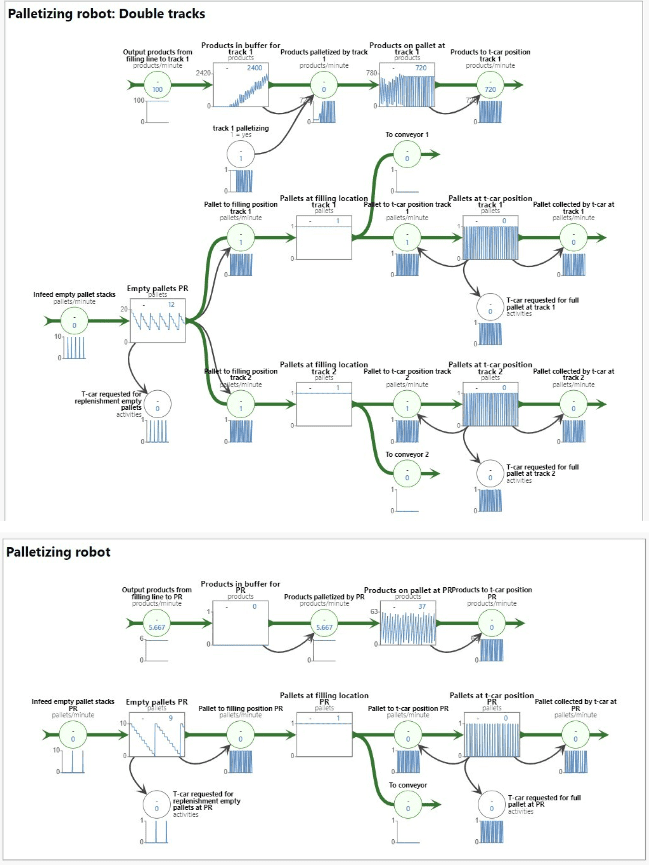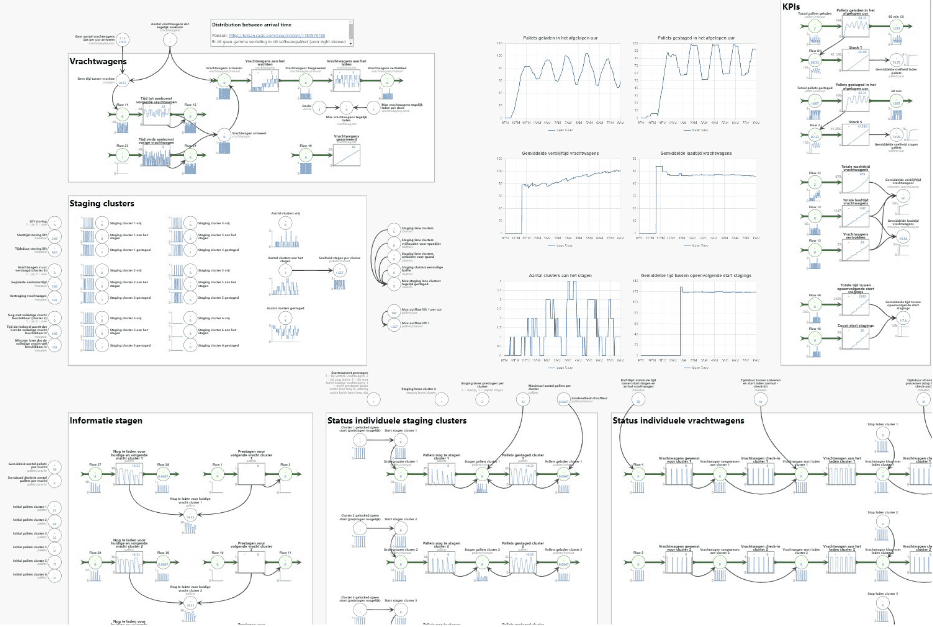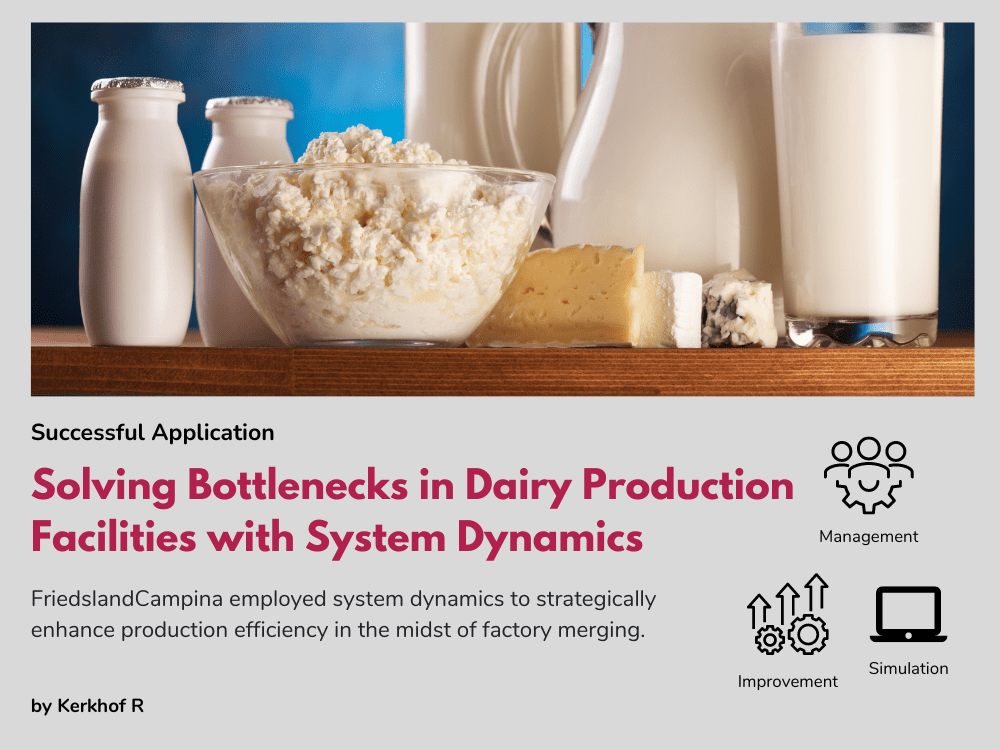Solving Bottlenecks in Dairy Production Facilities with System Dynamics
EXECUTIVE Summary
-
FrieslandCampina faced potential bottlenecks in production due to the merging of two factories. They hired SD&Co which employed system dynamics simulation models to predict and manage these issues effectively, ensuring smooth operational integration.
-
The project led to strategic changes, such as optimizing algorithms for pallet selection and adding a conveyor belt system, thereby enhancing efficiency without the need for extensive physical expansion of facilities.
-
The implemented changes have prepared FrieslandCampina to handle increased production volumes and maintain efficiency even in scenarios of partial factory downtime, demonstrating a successful adaptation to the merger’s demands.
#FriedslandCampina #SD&Co #Diary #Netherlands
The Problem
FrieslandCampina, a Dutch cooperative, specializes in transforming milk from dairy farmers into a wide array of dairy products. They were undertaking a significant project: merging two of their production facilities. This merger was anticipated to introduce new challenges, particularly in the filling and palletizing stages, as well as in the operations of their fully automated warehouse. The project was handled by SD&Co and their primary goal was to foresee potential bottlenecks under various post-merger production scenarios. Identifying these potential bottlenecks was crucial to ensure a smooth transition and maintain efficiency. Additionally, SD&Co was tasked with devising strategies to address these bottlenecks in the most effective and efficient manner possible, keeping in mind the operational workflow and the increased scale of production due to the merger.

Figure 1 – FrieslandCampina’s production facility
The Solution
FrieslandCampina faced a significant challenge: implementing changes to their factory could take up to two years. This long time frame posed a risk of reduced production output or the possibility of overinvesting in capacity expansion. The complexity of the situation was heightened by the interconnected nature of the factory and warehouse processes, which made it challenging to accurately predict outcomes using traditional tools like spreadsheets.
To navigate these complexities, SD&Co employed a comprehensive approach by developing four distinct simulation models. Each model varied in scope and level of detail, enabling a thorough analysis of a wide range of production scenarios and potential physical modifications to both the factory and the warehouse. These simulations were instrumental in testing the effects of various changes and understanding their impact on the overall operations.
Thanks to these sophisticated simulation models, FrieslandCampina and its suppliers were able to pinpoint the most effective and efficient solutions. They could identify adjustments to the factory and warehouse that would best accommodate the increased volumes resulting from the merger of the factories. This strategic approach allowed for a well-informed decision-making process, ensuring that the adjustments made were optimally aligned with the new operational requirements.

Figure 2 – Examples of sectors of the system dynamics model developed by SD&Co.

Figure 3 – Overview of simulation dashboards.
Outcomes
In this pivotal project, SD&Co identified the most efficient modifications necessary for the factory and warehouse to handle the increased volumes post-merger. FrieslandCampina, in collaboration with its suppliers, is actively implementing these recommended changes. The key deliverables of this project were the innovative simulation models and a comprehensive presentation detailing the recommended changes. These system dynamics tools provided valuable insights, leading to strategic adjustments within the operational framework of FrieslandCampina.
One significant change was the refinement of the algorithm that manages the selection of pallets for outbound elevators. This adjustment negated the need for physical expansion of the outbound elevators and staging lanes, thereby optimizing existing resources.
Additionally, they introduced a small conveyor belt behind two palletizers to avoid the need for a more extensive and costly redesign of the internal transport system around the palletizers.
Based on the simulation, FrieslandCampina also made a strategic decision to refrain from further investments. The model demonstrated that the new capacity would be adequate across a variety of production scenarios. This included scenarios where parts of the factory might temporarily break down or require maintenance. The project’s outcomes have significantly contributed to the robustness and efficiency of FrieslandCampina’s operations. The implemented changes ensured that the factory and warehouse can smoothly handle increased volumes, while providing a buffer for unforeseen production challenges.
Do you want to know more?
Connect with Roland van de Kerkhof.
OTHER SUCCESSFUL APPLICATIONS
A Design Value Calculator: A System Dynamics Boardgame
A Design Value Calculator: A System Dynamics Boardgame EXECUTIVE Summary Product design is a specific form of complex innovation that touches all areas of an organization’s management. While entrepreneurs recognise the value of design, they often tend to focus...
The World Bank Uses System Dynamics to Identify Root Causes of Poverty
The World Bank Uses System Dynamics to Identify Root Causes of Poverty EXECUTIVE Summary Madagascar has one of the highest poverty rates in the world. In 2022, an astonishingly three out of every four people in Madagascar lived below the poverty line. Poverty has...
Fast-Track Cities Uses System Dynamics to Enhance HIV Care
Fast-Track Cities Uses System Dynamics to Enhance HIV Care EXECUTIVE Summary Low levels of viral suppression at 69% for people with HIV make it hard to believe the 95% target level will be achieved by 2030 in St. Louis, USA. As a solution, Fast-Track Cities-STL opted...
Upcoming Events

How Did En-ROADS Get 755,000 users? Lessons on Modeling, Interface Design, and Facilitation
May, 8 at 11 am NY | 4 pm London | 11 pm Beijing | Time Converter How Did En-ROADS Get 755,000 Users? Lessons on Modeling, Interface Design, and Facilitation In this participatory webinar, Drew Jones of Climate Interactive will share insights on how to create a System...
Recent Posts
Society Governance Updates
Society Governance Updates Welcome, Allyson! New President Allyson Beall King joined the Policy Council as our 2024 President. Her primary role is as director of the Washington State University School of the Environment, which focuses on regional ecologies and our...
Call for Presenters: Seminar Series
Call for Presenters: Seminar Series We at the System Dynamics Society are continually seeking vibrant and knowledgeable presenters for our ongoing Seminar Series. As we unfold the calendar, there’s always a place for more insights, experiences, and expertise to enrich...
Honoring Excellence: A Glimpse into the Awards of the International System Dynamics Conference
Honoring Excellence: A Glimpse into the Awards of the International System Dynamics Conference The International System Dynamics Conference brings together experts, practitioners, and students to exchange ideas, showcase real-world applications, and celebrate...
Join us
OTHER SUCCESSFUL APPLICATIONS
A Design Value Calculator: A System Dynamics Boardgame
A Design Value Calculator: A System Dynamics Boardgame EXECUTIVE Summary Product design is a specific form of complex innovation that touches all areas of an organization’s management. While entrepreneurs recognise the value of design, they often tend to focus...
The World Bank Uses System Dynamics to Identify Root Causes of Poverty
The World Bank Uses System Dynamics to Identify Root Causes of Poverty EXECUTIVE Summary Madagascar has one of the highest poverty rates in the world. In 2022, an astonishingly three out of every four people in Madagascar lived below the poverty line. Poverty has...
Fast-Track Cities Uses System Dynamics to Enhance HIV Care
Fast-Track Cities Uses System Dynamics to Enhance HIV Care EXECUTIVE Summary Low levels of viral suppression at 69% for people with HIV make it hard to believe the 95% target level will be achieved by 2030 in St. Louis, USA. As a solution, Fast-Track Cities-STL opted...
Recent Posts
Society Governance Updates
Society Governance Updates Welcome, Allyson! New President Allyson Beall King joined the Policy Council as our 2024 President. Her primary role is as director of the Washington State University School of the Environment, which focuses on regional ecologies and our...
Call for Presenters: Seminar Series
Call for Presenters: Seminar Series We at the System Dynamics Society are continually seeking vibrant and knowledgeable presenters for our ongoing Seminar Series. As we unfold the calendar, there’s always a place for more insights, experiences, and expertise to enrich...
Honoring Excellence: A Glimpse into the Awards of the International System Dynamics Conference
Honoring Excellence: A Glimpse into the Awards of the International System Dynamics Conference The International System Dynamics Conference brings together experts, practitioners, and students to exchange ideas, showcase real-world applications, and celebrate...
Upcoming Events

How Did En-ROADS Get 755,000 users? Lessons on Modeling, Interface Design, and Facilitation
May, 8 at 11 am NY | 4 pm London | 11 pm Beijing | Time Converter How Did En-ROADS Get 755,000 Users? Lessons on Modeling, Interface Design, and Facilitation In this participatory webinar, Drew Jones of Climate Interactive will share insights on how to create a System...



Remarkable model. I was surprised that you would try this with “mere” system dynamics. We did so many years ago for a couple of clients and the moment processes are competing for resources the formulas became quite sophisticated (if-then formula covering a whole page). Our solution was to enhance our system dynamics software to feature process and resource factors and to indicate constraints over time (applying the Theory of Constraints). Nevermind, nice modeling!